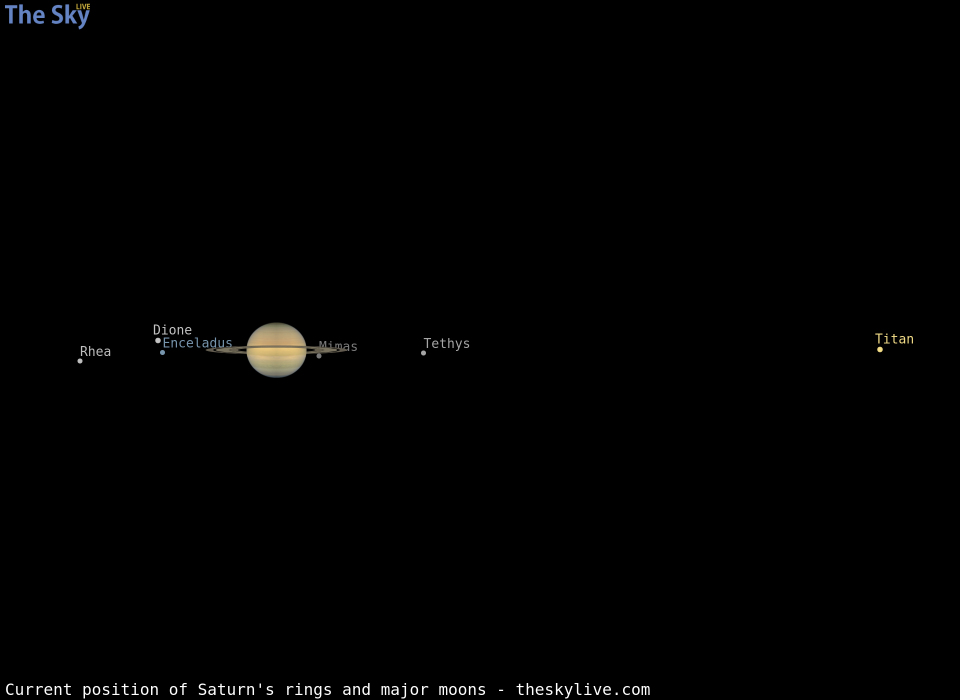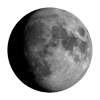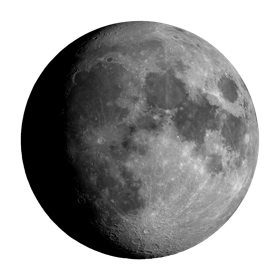Highlights
-
⭐A new interstellar object of cometary nature
approaching the inner Solar System, named 3I/ATLAS (alternative designation C/2025 N1), has been discovered by the "Asteroid Terrestrial-Impact Last Alert System" (ATLAS) survey.
Its orbit has an exceptionally high eccentricity of
e=6.18 . It should brighten up to magnitude 10 at the beginning of November this year. » 3I/ATLAS complete information. - The Sun is in Gemini, the Moon is Waxing Gibbous in Libra
- T CrB: magnitude
9.950 ± 0.008 [2025-07-05 07:56:30 UTC, CCD/V, RHM/AAVSO] -
Mercury is in very favorable conditions for evening observations with a solar elongation of
25.8° (sky map) - Comet 217P/LINEAR:
magnitude
12.9 in Orion - Comet 29P/Schwassmann-Wachmann:
magnitude
13.6 in Leo - Comet C/2021 G2 (Atlas):
magnitude
13.6 in Libra -
Next NEO approach:
Asteroid (NEO) 2025 MN88,
Jul 6 2025 at 11:53 UTC,739,006 km,1.92 lunar distances - Pluto is close to opposition
- KBO 2014 MU69 (Ultima Thule) is close to opposition
Popular Objects
Popular objects during the last 7 days based on the number of visualizations.
The Solar System
Current positions of the major bodies of the Solar System and the brightest comets.
Sun and Moon
How the Sun and the Moon look like today.
| R.A. | Decl. | Apparent Diameter | MagnitudeMag | ConstellationConst | Charts | |
|---|---|---|---|---|---|---|
| Sun | 07h 02m 16s | +22° 39’ 44” | 1,887.5” | -26.71 | Gemini | map my_location |
| Moon | 15h 05m 36s | -22° 39’ 49” | 1,773.6” | -11.14 | Libra | map |
The Planets
Current essential information about the planets. Click each planet to view full details.
| Planet | R.A. | Decl. | Diameter | MagnitudeMag | ConstellationConst | Charts |
|---|---|---|---|---|---|---|
| Mercury | 08h 50m 00s | +17° 18’ 17” | 8.4” | 0.61 | Cancer | map my_location |
| Venus | 04h 00m 17s | +18° 00’ 42” | 17.1” | -4.11 | Taurus | map my_location |
| Mars | 10h 50m 24s | +08° 24’ 11” | 4.8” | 1.43 | Leo | map my_location |
| Jupiter | 06h 26m 03s | +23° 10’ 43” | 31.3” | -1.89 | Gemini | map my_location |
| Saturn | 00h 10m 31s | -01° 19’ 18” | 17.3” | 0.93 | Pisces | map my_location |
| Uranus | 03h 51m 15s | +19° 55’ 57” | 3.5” | 5.81 | Taurus | map my_location |
| Neptune | 00h 10m 04s | -00° 21’ 16” | 2.3” | 7.75 | Pisces | map my_location |
Jupiter Moons
Position of the Galilean satellites of Jupiter. A dedicated tool is available, with more advanced features.

List of 5 upcoming phenomena of Jupiter's satellites:
| Date | Local Time | Satellite | Event |
|---|---|---|---|
| Jul 6 | 23:47 | Io | Begin Eclipse |
| Jul 7 | 02:14 | Io | End Occultation |
| Jul 7 | 10:57 | Europa | Begin Shadow Transit |
| Jul 7 | 11:22 | Europa | Begin Transit |
| Jul 7 | 13:38 | Europa | End Shadow Transit |
To see the complete list of the upcoming phenomena for the next 7 days consult the dedicated Jupiter's Galilean Moons section.
Saturn Moons & Rings
Inclination of the rings of Saturn and positions of major satellites. A dedicated tool is available, with more advanced features.

Apparent Planet Sizes
Comparison between the apparent size of the planets, measured in seconds of a degree, as they appear today.

8.4”

17.1”

4.8”

31.3”

17.3”

3.5”

2.3”
Credits for the planet images: NASA-APL - NASA.
Brightest Comets
List of the 10 brightest comets (open the full list of 249 comets).
| Comet | R.A. | Decl. | Magnitude (COBS)Mag Obs | Magnitude (JPL)Mag Pred | ConstellationConst | Charts | ||
|---|---|---|---|---|---|---|---|---|
| 217P/LINEAR | 04h 53m 46s | +14° 36’ 08” | 12.9 | 16.36 | Orion Ori | map my_location | ||
| 29P/Schwassmann-Wachmann | 10h 02m 05s | +08° 25’ 27” | 13.6 | 17.90 | Leo Leo | map my_location | ||
| C/2021 G2 (Atlas) | 15h 05m 55s | -01° 28’ 43” | 13.6 | 15.19 | Libra Lib | map my_location | ||
| C/2014 UN271 (Bernardinelli-Bernstein) | 04h 58m 32s | -66° 14’ 46” | 14.2 | 17.65 | Dorado Dor | map my_location | ||
| P/2010 H2 (Vales) | 13h 16m 09s | -00° 10’ 17” | - | 14.24 | Virgo Vir | map my_location | ||
| C/2022 E2 (ATLAS) | 01h 48m 37s | +53° 46’ 13” | 14.7 | 15.38 | Perseus Per | map my_location | ||
| C/2022 N2 (PANSTARRS) | 02h 40m 13s | +20° 31’ 29” | 15.0 | 15.20 | Aries Ari | map my_location | ||
| C/2023 C2 (ATLAS) | 23h 43m 39s | +47° 20’ 03” | 15.2 | 16.21 | Andromeda And | map my_location | ||
| C/2025 K1 (ATLAS) | 21h 59m 20s | +22° 01’ 12” | 15.4 | 15.69 | Pegasus Peg | map my_location | ||
| C/2024 J2 (Wierzchos) | 02h 40m 57s | +00° 15’ 23” | - | 15.44 | Cetus Cet | map my_location |
We acknowledge with thanks the comet observations from the COBS Comet Observation Database contributed by observers worldwide and used in this table to report recent comet observations.
Brightest Asteroids
List of the 10 brightest asteroids (open the full list of 79 asteroids and dwarf planets.)
| Asteroid | R.A. | Decl. | MagnitudeMag | ConstellationConst | Charts | ||
|---|---|---|---|---|---|---|---|
| 4 Vesta | 14h 27m 49s | -07° 41’ 54” | 6.78 | Virgo | map my_location | ||
| 6 Hebe | 22h 41m 44s | -07° 04’ 09” | 8.91 | Aquarius | map my_location | ||
| 1 Ceres | 01h 06m 05s | -05° 15’ 49” | 8.95 | Cetus | map my_location | ||
| 2 Pallas | 20h 58m 35s | +17° 22’ 10” | 9.71 | Delphinus | map my_location | ||
| 7 Iris | 06h 07m 05s | +23° 06’ 07” | 9.86 | Gemini | map my_location | ||
| 3 Juno | 15h 12m 41s | -02° 02’ 57” | 10.61 | Libra | map my_location | ||
| 15 Eunomia | 08h 32m 29s | +15° 27’ 02” | 10.80 | Cancer | map my_location | ||
| 20 Massalia | 06h 34m 57s | +22° 44’ 57” | 10.90 | Gemini | map my_location | ||
| 9 Metis | 14h 37m 02s | -14° 16’ 41” | 10.97 | Libra | map my_location | ||
| 349 Dembowska | 14h 42m 09s | -20° 58’ 34” | 11.11 | Libra | map my_location |
Active Meteor Showers
List of the currently active meteor showers.
| Name | Peak | Radiant R.A. | Radiant Decl. | ZHR ⓘ | Rating | Parent Object | Charts | |
|---|---|---|---|---|---|---|---|---|
| Alpha Capricornids | 30 Jul | 20h 30m | -10° | 5 | bright | map | ||












